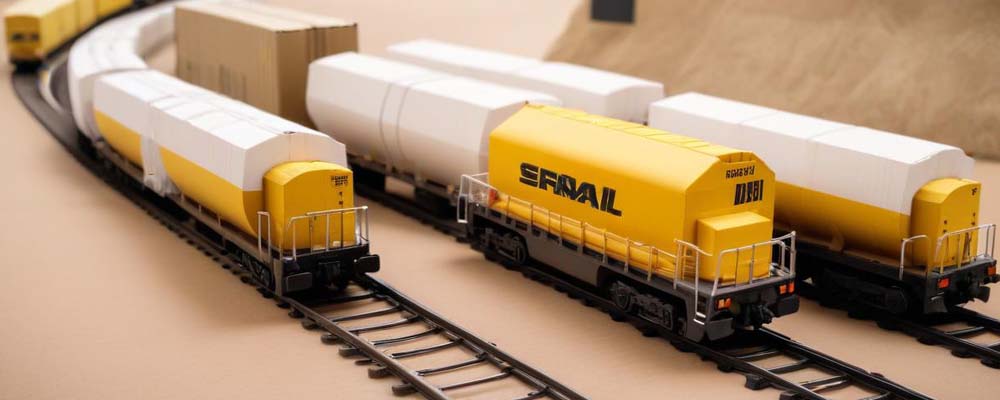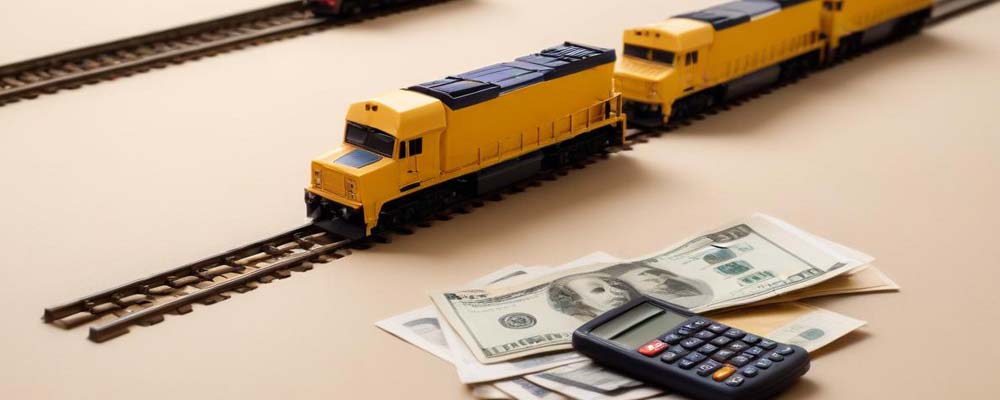
Understanding the rail freight shipment process can be a game-changer for your operations. In this blog, we’ll break down everything you need to know about rail freight, from its benefits to step-by-step instructions on how to get started. By the end, you’ll be equipped with actionable insights to streamline your supply chain and reduce costs.
The Advantages of Rail Freight
Rail freight offers significant advantages over other transportation methods. Firstly, it’s cost-effective for long-distance shipping. Trains can carry large volumes of goods at a lower cost compared to trucks or air freight. This makes rail an excellent choice for heavy and bulky items.
Secondly, rail freight is eco-friendly. Trains have a lower carbon footprint than trucks, making them a more sustainable option. If sustainability is a priority for your business, rail freight can help you reduce your environmental impact.
Lastly, rail freight is reliable. Trains adhere to strict schedules, ensuring timely delivery of goods. Unlike road transport, rail is less affected by traffic congestion, providing a more predictable transit time.
Understanding Rail Freight Terminology
Before we dive into the process, it’s essential to familiarize yourself with key rail freight terms. Consignor refers to the person or company sending the goods. Consignee is the recipient. Waybill is a document listing the details of the shipment. Understanding these terms will help you navigate the rail freight process more effectively.
Choosing the Right Rail Freight Service
Selecting the right rail freight service is crucial. Different services cater to varying needs. For instance, intermodal rail uses containers that can be transferred between trucks, ships, and trains, offering flexibility. On the other hand, carload rail is ideal for transporting bulk commodities like coal or grain.
Consider your shipment’s size, weight, and destination when choosing a service. Consulting with a rail freight specialist can also provide valuable insights tailored to your specific needs.
Preparing Your Shipment
Proper preparation is key to a smooth rail freight process. Start by accurately measuring and weighing your goods. Incorrect measurements can lead to delays and additional costs. Ensure your goods are securely packaged to withstand the rigors of rail transport.
Next, complete all necessary documentation. This includes the waybill, customs forms if shipping internationally, and any other required paperwork. Accurate documentation prevents delays and ensures compliance with regulations.
Booking Your Shipment
Booking your rail freight shipment involves several steps. First, contact your chosen rail freight service provider. Provide them with detailed information about your shipment, including dimensions, weight, and destination. They will generate a quote based on the information provided.
Once you agree on the terms, schedule a pick-up date. Ensure your goods are ready and accessible for loading on the specified date. Timely communication with your service provider is crucial to avoid any hiccups.
Loading and Securing Goods
Loading your goods onto the train requires careful planning. Ensure that your cargo is evenly distributed to maintain balance. Use securing materials like straps and braces to prevent movement during transit. Properly secured goods minimize the risk of damage.
Rail cars have various loading options, such as boxcars for general cargo and flatcars for oversized items. Choose the appropriate car type based on your shipment’s requirements.
Tracking Your Shipment
Tracking your rail freight shipment is essential for transparency and peace of mind. Most rail freight services offer tracking systems that provide real-time updates on your shipment’s status. This enables you to track its progress and anticipate any potential delays.
Regularly checking the tracking information ensures you’re informed at every stage of the process. If any issues arise, you can address them promptly to avoid disruptions.
Customs and Clearance
For international shipments, customs clearance is a critical step. Ensure all customs documentation is complete and accurate. This includes commercial invoices, packing lists, and certificates of origin.
Collaborating with a customs broker can simplify this process. They have the expertise to handle customs regulations and ensure your shipment complies with all requirements. Proper clearance prevents delays and ensures a smooth transition through customs.
How Is Rail Freight Cost Calculated?
Understanding how rail freight costs are calculated is essential for effective budgeting and logistics planning. Rail freight charges are typically determined by several key factors:
Distance and Weight
The primary components of rail freight cost are the distance the shipment will travel and its weight. Costs are generally calculated on a per ton-mile basis, meaning heavier shipments and longer distances will incur higher fees.
Type of Goods
The nature of the cargo also influences the cost. Hazardous materials, perishable goods, and oversized items may require special handling, equipment, or permits, leading to additional charges.
Service Level
Various service options, such as expedited shipping or temperature-controlled rail cars, can impact the overall cost. Premium services usually come at a higher price but offer benefits like faster transit times and specialized care.
Loading and Unloading Services
Fees for loading and unloading cargo onto and off the rail cars can add to the total cost. These services ensure that your goods are handled safely and efficiently, but they are an extra expense to consider.
Accessorial Charges
Additional services, known as accessorial charges, can include fees for storage, detention (delays in loading or unloading), and demurrage (use of rail cars beyond the agreed time). These charges can add up, making it vital to manage the logistics carefully to avoid unnecessary costs.
Fuel Surcharges
Rail companies may include fuel surcharges to cover fluctuating fuel prices. These surcharges vary depending on fuel costs and can affect the total freight cost.
By understanding these components, businesses can better estimate their rail freight costs and make informed decisions when selecting rail services. Always request a comprehensive quote from your rail freight provider to ensure all potential charges are accounted for.
Sample Computation of Rail Freight Cost
To illustrate how rail freight costs are calculated, let’s consider an example where a business needs to ship 50 tons of machinery over a distance of 500 miles. Here is a step-by-step breakdown of the costs involved:
Distance and Weight Calculation
- Weight of shipment: 50 tons
- Distance: 500 miles
- Cost per ton-mile: $0.05
- Total cost for distance and weight: 50 tons x 500 miles x $0.05/ton-mile = $1,250
Type of Goods
- Machinery, requiring standard handling
- Additional charge for handling machinery: $200
Service Level
- Standard service with no expedited options
- Additional charge: $0
Loading and Unloading Services
- Loading fee: $100
- Unloading fee: $100
- Total loading and unloading cost: $100 + $100 = $200
Accessorial Charges
- Storage fee: $0 (not applicable in this example)
- Detention fee: $0 (not applicable in this example)
- Demurrage fee: $0 (not applicable in this example)
- Total accessorial charges: $0
Fuel Surcharges
- Fuel surcharge rate: 3% of distance and weight cost
- Total fuel surcharge: $1,250 x 3% = $37.50
Summing up all the costs:
- Distance and weight cost: $1,250
- Handling machinery charge: $200
- Loading and unloading services: $200
- Accessorial charges: $0
- Fuel surcharge: $37.50
Total rail freight cost:
- Total: $1,250 + $200 + $200 + $0 + $37.50 = $1,687.50
This sample computation gives you a clear idea of how various factors contribute to the overall cost of rail freight. By breaking down each component, businesses can accurately estimate and budget for their shipping needs.
Benefits of Rail Freight Insurance
While rail freight is generally safe, unforeseen events can occur. Investing in rail freight insurance provides peace of mind and financial protection. Insurance covers potential losses or damages during transit, ensuring you can recover costs if anything goes wrong.
Consult with your service provider to understand the insurance options available. Choose a policy that aligns with the value and nature of your goods.
Common Challenges and Solutions
Despite its advantages, rail freight can present challenges. One common issue is transit delays. While rail is less affected by traffic, factors like weather conditions and rail network congestion can cause delays.
To mitigate this, build buffer time into your delivery schedule. Regularly communicate with your service provider for updates. Another challenge is cargo security. Ensure your goods are properly secured and consider using security seals to deter theft.
Sustainability and Rail Freight
Sustainability is a growing concern for businesses. Rail freight’s lower carbon footprint makes it an attractive option for environmentally conscious companies. Opting for rail over road transport can significantly reduce your company’s greenhouse gas emissions.
Additionally, many rail companies are investing in greener technologies, such as electric trains powered by renewable energy. By choosing rail freight, you’re not only optimizing your logistics but also contributing to a more sustainable future.
Future Trends in Rail Freight
The rail freight industry is evolving with technological advancements. Digitalization is transforming how rail freight operates. Technologies like IoT (Internet of Things) enable real-time tracking and monitoring of shipments, enhancing transparency and efficiency.
Automation is another trend to watch. Autonomous trains and robotic loading systems are being tested to further streamline the process. Staying informed about these trends can help your business stay competitive in the logistics landscape.
Conclusion
Mastering the rail freight shipment process can give your business a significant edge. From cost savings to sustainability benefits, rail freight offers numerous advantages. By understanding the process and leveraging the right tools and services, you can optimize your supply chain and enhance your operational efficiency.











